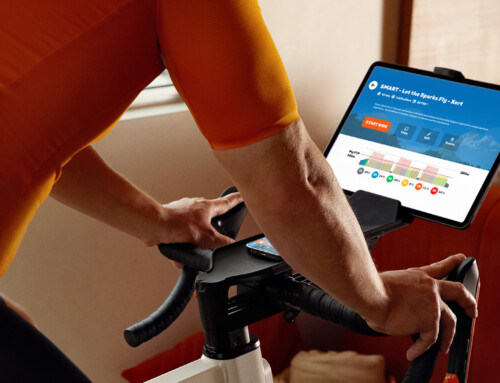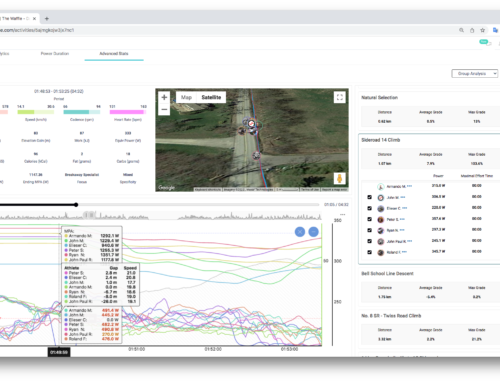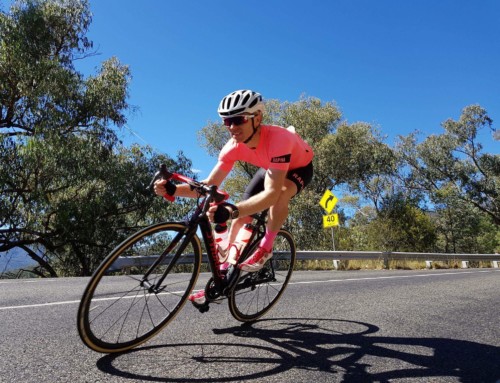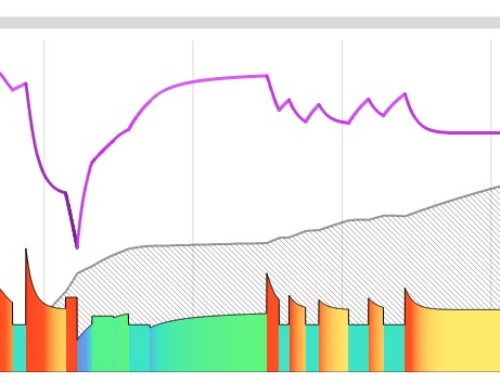Our customers asked and we responded. By popular demand, we launched our own podcast where we discuss the amazing new insights into your training and performance that are provided through the unique lens of Xert. You’ll get an entirely new perspective on understanding power data from your cycling or running, helping you achieve new levels in your fitness and race performance. The podcast features Scott Steele, Dr. Stephen Cheung and Armando Mastracci, founder of Xert, sharing their ideas on various topics. Tune in to these podcasts to learn something new about yourself and how you can become a better endurance athlete.
The “Xert Breakthrough Lab” podcast is available on:
You’ll also find it on other podcast platforms that pull from these sources.
Episode 1 – Breaking Through with Xert
Our first podcast, complete with newbie podcast recording errors. It’s raw, but totally worth a listen to. In this podcast, we talk all about fitness breakthroughs and this unique aspect of Xert.
Key discussion points in the podcast:
- What is a Fitness Breakthrough (2:00)
- Comparing a Fitness Breakthrough with a Personal Best (4:42)
- How breakthroughs account rests, traffic or starting fatigue during efforts (6:43)
- The benefits of measuring fitness using breakthroughs (9:08)
- FTP Testing and different ways to test with Xert (13:05)
- Maximal efforts, points-of-failure and extended efforts at MPA (16:00)
- Dr. Cheung talks about recovering from injury (21:56)
- How to get a breakthrough (27:28)
- Near Breakthroughs / “Fakethroughs” (30:09)
- Signature Decay Method (37:15)
- Using the No Decay Method (38:50)
- Types of Breakthroughs (40:06)
- The alignment of breakthroughs and your training (42:10)
- Breakthrough Errors (43:48)
- Using breakthroughs to compare one mode of riding to another (48:00)
Episode 2 – Your Fitness Signature – 3 Numbers that Predict Performance
You are more than your FTP. In this episode, Scott, Stephen and Armando talk about Fitness Signatures and what they mean.
Key discussion points in the podcast:
- What is a Fitness Signature (0:42)
- How does a Fitness Breakthrough relate to your Fitness Signature (3:42)
- How does your signature relate to your Power Curve (6:28)
- Fitness Signatures from your FTP test (8:48)
- Differences between athletes (11:15, 23:10)
- What is the difference between HIE and W’ (13:37)
- Is HIE like a battery? (15:23)
- Modeling maximal power and fatigue with MPA (15:40)
- Workout models and design with MPA (19:30)
- How your signature help you understand how you recover from a high-intensity interval (21:42)
- How does your fitness signature relate to an Athlete Type (24:24)
- How athletes with different fitness signatures compete differently (27:20)
- Fitness signature strengths and weaknesses (29:09)
- What is Lower Threshold Power – LTP (32:15)
- Training with LTP (37:11)
- Using LTP in an event (39:27)
- How to assess the validity of your signature (40:48)
- Using the Fitness Signature calculator with a comparison to a CP/W’ calculation (42:45)
- Understanding the importance of having a good Peak Power value (44:58)
- Overestimates of Threshold Power (47:30)
- Why your Peak Power can be higher than your highest power effort (49:35)
- Analyzing the fitness signature and how it changed in a breakthrough activity (51:41)
- Gold, Silver and Bronze breakthrough medals (54:04)
- Introduction to how your signature parameters change with training (54:17)
- A Fitness Signature is both how to measure your fitness but also what you’re able to influence with training (56:30)
Episode 3 – From Time-Trialist to Sprinter – Athlete Types in Xert
How should you choose your Athlete Type? Learn about what it should be and what does means to your training and improvements.
Key discussion points in the podcast:
- Why were Athletes Types introduced (0:28)
- Athlete Types on the Power Curve (2:17)
- Conceptualizing Athlete Types by comparing them to running events (3:07)
- Interpreting stochastic/variable power data as an Athlete Type (8:10)
- How each fitness signature system contributes to the power needed be an Athlete Type (9:00)
- Training a single Fitness Signature parameter (21:18)
- Conceptualizing HIE and why it is a fitness signature parameter (12:38)
- Why are some Athlete Types measured in W and others in W/kg (14:34)
- Using your Ranking and the Spider/Radar Chart to help choose your Athlete Type (18:55)
- Using race and/or previous activities to help choose your Athlete Type (20:10)
- Choosing an Athlete Type based on a weakness (21:28)
- Why FTP isn’t the only measure of fitness (22:42)
- When to focus on long duration rides and volume (24:58)
- Knowing how to race with your strengths (26:39)
- Why looking at normalized or average power doesn’t help understand your Athlete Type (27:26)
- How the Athlete Type associates with the variability of efforts (30:40)
- Dr. Cheung talks about the Ronnestad workout .. again.. (31:08)
- How your chosen Athlete Type guides your training (33:03)
- Events and activities usually have mid-range Athlete Types (35:05)
- Periodization of your Training Program based on your Athlete Type (35:43)
- Changing your Athlete Type seasonally (37:59)
- When to choose an Athlete Type that might have a different duration than your event (39:30)
- Why you don’t always get a recommended workout that is based your chosen Athlete Type (41:10)
- Where are Athlete Types used on the system and your Focus hatched line (44:45)
- Why Breakaway Specialist Athlete Type is a great choice as an Athlete Type (48:38)
Episode 4 – Being SMART About Your Workouts
What makes a great workout? In this episode, Scott, Stephen and Armando share their experiences doing workouts and discuss how to compare one workout to another, when one is better than another and the unique aspects of Xert’s workouts that aren’t available in other other training systems.
Key discussion points in the podcast:
- What are workouts intended to do and why do workouts have a structure (1:14)
- Research on which workout works best (2:30)
- Modeling the 4×4, 4×8 and 4×16 workouts in Xert (4:14)
- How fatigue during a workout increases the benefits of training (6:30)
- Why different intervals impact different aspects of fitness (7:40)
- How MPA is used conceptually in Xert workouts (10:00)
- The development of a new interval definition using MPA (11:05)
- Why recovery intervals are so important (11:40)
- How the exact intensity, the exact recovery intensity and the exact durations are at the very core of what’s most important in your training(12:30)
- The importance of training efficiently (13:32)
- What are SMART intervals and workouts (14:50)
- Why using %FTP for workout interval targets can be problematic (16:40)
- What are Xert’s alternatives to using %FTP (18:14)
- Personalized Zones (19:07)
- Why we don’t to have so many workouts in Xert and why it’s not necessary (20:40)
- XSSR Intervals (22:30)
- Dr. Cheung’s explains one of his favourite workouts – Let the Sparks Fly (23:55)
- XSSR Intervals – Deeper Explanation (26:40)
- Difficulty Scores and Rating (28:40)
- How workouts are recommended based on your Training Load (30:40)
- Making sure workouts can be completed (32:14)
- Should you train to failure (34:07)
- Dr. Cheung talks about the Ronnestad workout .. again.. (36:30)
- Understanding Target MPA (38:40)
- Dynamic duration intervals (40:10)
- Dr. Cheung’s favourite workouts (43:55)
- Scott’s favourite workouts (46:07)
- The Closer workouts (47:46)
- Armando’s favourite workouts (49:30)
- Coach and community shared workouts (52:13)
- Lower intensity workouts in Xert (53:35)
- Workout intervals that are based on LTP (54:40)
Episode 5 – Tracking Your Training Load with XSS
How do you know how much training you’ve been doing? Is training just about high and low intensity workouts or are there other factors? How can you avoid or deal with plateaus? Learn about how Xert measures training intensity and volume, creating a new level of precision in understanding your specific training and progression.
Key discussion points in the podcast:
- Traditional methods to measure training volume (00:50)
- Using heart rate and zones (3:06)
- Using a power meter (4:00)
- Using normalized and average power (4:40)
- From time, distance, heart rate zones, power zones to Xert’s 3-dimensional XSS (5:16)
- Xert jumps two of the major hurdles encountered with traditional zone methods (7:00)
- Never waste a good effort (8:15)
- XSS can be greater than 100 per hour (9:47)
- Order matters (10:13)
- XSS doesn’t exhibit the issues that exist with older methods (11:25)
- XSS Rate (XSSR) data is now on the charts in varying colour (13:30)
- How XSS is used to measure overall training – volume and intensity (15:10)
- Carving XSS into 3 and Training Loads (16:28)
- How volume and intensity affects Training Loads (17:25)
- Polarity Ratio (17:50)
- Why multiple dimensions to Training Load are needed (19:00)
- Time constants and Program Phases (20:55)
- Trade offs (21:18)
- Why you can lose fitness by doing high intensity (21:45)
- What’s better, high or low intensity (24:00)
- Why can XSS be greater than 100 per hour and what is Difficulty Score (25:10)
- First rule of doing time-trials: “Don’t go out too hard.” (27:15)
- How Difficulty Score came about. (28:20)
- Getting high Difficulty Scores (29:44)
- Why handling higher Difficulty Scores is so important (31:35)
- Managing Difficulty Score and intensity (33:10)
- Why Difficulty Score is low for very long “difficult” rides and pacing (33:56)
- Hardness Tests (36:28)
- Training loads can’t go up forever (38:38)
- Plateaus (40:20)
- When it is ok to let Training Load detrain and go down (41:10)
- How to “game” the system (42:09)
- What your target Training Load should be for an event (43:57)
- Why building base fitness is important over the off season (45:10)
Episode 6 – What to look for in a Training Program
Learn about what makes a great training program and how to train towards a goal. How does Polarized Training work in Xert? The Xert Team talk about training plans and programs, discussing the basic principles of training and what you need to do to ensure you improve.
Key discussion points in the podcast:
- Training Program vs. Training Plan (02:40)
- Elements of a good training plan (03:57)
- Matching a Training Plan to the Individual (04:32)
- Can you lose fitness with a training plan? (05:15)
- Should people with the same Fitness Signature and same goals have the same plan? (06:00)
- How hours per week and overall strain affect the program. (08:00)
- What a good coach will help you with. (08:42)
- How can you self-coach with Xert? (09:13)
- How is the Adaptive Training Advisor different? (10:45)
- What does “adaptive” mean? (11:15)
- Working with a coach. (12:27)
- Limits of an inexpensive training plan. (013:20)
- What can power data say about how you are feeling? (15:00)
- Freshness Feedback (16:20)
- Recovery Weeks (17:40)
- Sustainable Improvement Rates (19:08)
- Signs of Overtraining (20:20)
- Making time for recovery during the season (21:12)
- When rest periods make the most sense (23:00)
- When training is too easy (24:55)
- Dr. Cheung’s recovery from injury (25:50)
- Polarized vs. Sweetspot Training (28:25)
- Training Xert’s 3 systems and Training Status colours(30:18)
- Front-loaded Periodization (32:15)
- Testing out different training strategies with Xert’s Fitness Planner (34:30)
- Overreaching (35:33)
- When is sweetspot effective or ineffective? (37:15)
- Why do Base training? (38:45)
- Mentally draining workouts (40:30)
- How does Xert accelerates benefits using fatigue (41:42)
- Leveraging fatigue to increase training efficiency (42:10)
- Planning for target events using Xert’s Training Program (44:48)
- When is structure needed in your training? (45:40)
- Xert’s Training Program phases and focus (47:20)
- A, B and C events planning (48:30)
- Adjusting your Athlete Type and Improvement Rate (50:00)
- Training without a target event. (52:00)
- How do you prepare and taper for an event. (54:00)
- How to know if you have enough training load for an event (56:00)
Episode 7 – Getting Advice On What You Need To Do To Improve
In this week’s episode, Scott, Stephen and Armando discuss the Xert Adaptive Training Advisor and how to incorporate the advice it provides into your training. Listen in to find out how the advisor examines your data to present you with recommendations and advice that will help you understand what you’ll need to do to improve.
Key discussion points in the podcast:
- Overview of the Xert Player for iOS app (02:02)
- The Training Pacer – XSS deficit and surplus (03:45)
- Progressive Overload in a Training Plan (05:20)
- Ramp Rates (06:10)
- Rolling 7 day Improvement Rate (07:00)
- Basic principles of training deficits / improvement (08:44)
- Understanding what it takes to keep improving (11:28)
- Using the Training Pacer as a motivator (14:30)
- Higher training loads requires more training time to improve (16:00)
- Adjusting your Improvement Rate during the training year (16:35)
- Ensuring you recover even when you have a deficit (17:30)
- Is the adaptive training advisor a replacement for a coach? (19:00)
- Understanding the recommended training (20:30)
- How recommended workouts are determined (23:00)
- Choosing other recommended workouts (24:37)
- Using Freshness Feedback to influence the recommended training (25:30)
- How Xert helps both the athlete and the coach (27:12)
- Going “off plan” with other rides and races during your program (28:40)
- Warnings you might see from the advisor. (30:48)
- Can you improve forever? (32:20)
- What is Today’s Advice and what you need to do at any given point in your training (34:20)
- Planning workouts into the future (36:40)
- Learning to trust the immediate advice (38:55)
- How often should I do a test? (41:00)
- Optimal Decay Method and breakthroughs (42:10)
- Setting the No Decay Signature Decay Method (43:24)
- Ronnestad Workout for breakthroughs (47:17)
- What to do when you have large jumps/drops in training (47:50)
- Following the program without doing structured workouts (50:40)
- Understanding Focus Duration in the recommendations (51:40)
- Using the Xert Player for iOS app (02:02)
- Substituting workouts with races or group rides in your training (53:40)
Episode 8 – Preparing for your Best Season
- Xert’s new feature – HR Derived Metrics (1:50)
- Strava Integrations (4:40)
- What to examine with Xert at the end of the season? (7:00)
- Take time off or pick up another activity (7:40)
- Letting your training load & fitness come back down (8:45)
- Getting away from structured training (9:50)
- Not necessary to manage XSS deficits (12:00)
- You can aim for breakthroughs, but you don’t need to (13:30)
- Consider an annual physical & check in on overall health (14:50)
- Consider weight training (16:30)
- Consider a bike fit (17:00)
- Reflecting back on your season (18:00)
- Reviewing your year in Xert, XPMC, Fitness Signatures (18:30)
- Using the XPMC & Table in Xert (19:20)
- Review qualitative notes from your activities (22:30)
- Looking at fakethroughs for insight (25:15)
- Ease back into training (26:30)
- How to prepare for next season? (27:40)
- Why Xert’s training program is only 120 days (30:00)
- Structured training is mentally taxing (34:00)
- Explaining Xert’s time constants (36:25)
- Scott, Stephen, and Armando talk about their plans for 2020 (37:50)
- Switching from a bike power meter to a smart trainer with power matching (41:30)
- Can’t hit the same numbers indoors, what do I do? (44:25)
- Consider checking/replacing handlebar tape (50:45)
- Customer Questions (52:00)
Episode 9 – Work out the SMART Way
- The different ways to work out with Xert (2:50)
- Review Episode 4 – Being SMART About Your Workouts (3:50)
- Using the Remote Player (6:00)
- Guide to Training with Zwift and Xert (9:45, link here)
- Limitations to exported Xert workouts (11:00)
- Android App can be used as a headunit (15:15)
- Freestyling a workout (18:50)
- Why was my workout longer than expected? (19:50)
- Using different trainer modes to perform workouts (24:00)
- Breakthrough workouts in Xert (28:50)
- Stephen talks about using Xert workouts with rollers (32:00)
- High power intervals are quite common in Xert, why? (35:40)
- What makes a workout difficult? (43:00)
- Mental aspects that make a workout difficult (47:30)
- The way you train is aligned with what you’re aiming to do (51:40)
- Incorporating unstructured winter racing with structured workouts (52:45)
- Shared workouts community (55:45)
Episode 10 – Christmas 2019 Q & A in the XBL with Friends
Recorded with our Xert friends at the Xert Breakthrough Lab offices, Scott, Stephen and Armando answer questions about Xert. Listen in to hear about what users are wanting to know more about.
Episode 11 – Measuring Training – From Hours to Xert’s Focus
How much training do you do? How much should you do? How much is too much? How much is too little? What are the best intervals to do? To answer these questions, we first have to ask ourselves: How do we measure training?
Episode 12 – Should I be doing structured workouts? Which ones?
What happens if I ignore my training program? What happens if I never miss a workout? When can I just pick my own workout? What about tapering? The Xert gang examines the numbers to help answer these questions. Tune in to understand when you should be paying attention to your training and what you need to do to become your best.
Episode 13 – An Introduction to Real-time Xert
The gang gets into real-time data using your Garmin Connect IQ data fields. Listen to all the various ways to use these unique data fields and how they are set up. Those that don’t have a compatible Garmin will also get an appreciation for what’s possible.
Episode 14- How Xert Came to Be
The gang got together to talk about the origins of Xert and what led to its development. Take a trip down memory lane with Armando, Scott and Stephen to find out about the historical events and discoveries that eventually became the foundation of Xert and all its unique features and capabilities.
Episode 15 – Question and Answer Session #2
The gang answers questions from Xerters in the second q&a podcast, like:
1. Where can I get help with Xert?
2. What is XSSR, how do I use it and how is related to Difficulty Score and Maximal Effort Time?
3. Why do longer intervals feel harder than shorter intervals but I get more XSS for the shorter ones?
4. Why is it hard to see MPA come down at the end of a long ride?
5. Why can’t I reach MPA?
6. Where can I find about the XSS that applies to my low, high and peak systems?
7. Why does Xert count all my stops in the calculation of averages?
8. How do I best use the Fitness Planner?
Episode 16 – Training and Detraining During A Pandemic
Many Xerters from around the world are being affected by the growing COVID-19 pandemic. In this podcast, the crew talk about how this may be affecting your training and fitness and things that you may want to do during these difficult times.
Episode 17 – Post Lockdown Training with Tips and Tricks to Managing Your Progression
It’s May and COVID-19 lockdowns are slowly lifting. The gang talks about doing the Ronnestad workout for breakthroughs and about getting back to outdoor training and riding. We also spend time talking about tips and tricks to managing your progression data.
Episode 18 – What Makes Xert’s MPA and Fitness Signature Different – A Deep Dive
The Xert gang goes deeper into how MPA and your Fitness Signature work and make sense of your data. Learn how to know when your numbers are dialled-in or whether something might be wrong in your progression and analysis.
Episode 19 – Dissecting Pro Racing with Xert
Why do Puncheurs excel at the classics? Do GC contenders on the grand tour have a big or small High Intensity Energy capacity? Listen to Stephen, Armando and Scott discuss the nature of pro cycling through the lens of Xert to understand how racing translates into its concepts and principles.
Episode 20 – Talking Science
From A.V.Hill to Monod Scherrer to Seiler, the gang talks about the research and how it relates to Xert. Geeky cool. Listen in.
Episode 21 – Making Things Simple by Shifting Paradigms
Zones are easy to understand but much too cumbersome for the average athlete to use effectively. Xert’s Focus Duration simplifies the complex task of understanding how each athlete’s fitness is unique, how performance demands differ from one type of ride to another and how to optimize your training to get the most out of your workouts. Join the gang to learn about Focus Duration, this unique Xert feature.
Episode 22 – Kicking Off a New Season with MVDP’s Breakthrough at Strada Bianche
After a bit of a hiatus, the gang gets together again to get caught up on everything that’s been happening. Listen to their stories about reaching new levels and injury recovery with an added unique perspective of MVDP’s performance at Strade Bianche.
Episode 23 – What is this Xert EBC thing?
EBC. Does it stand for anything? What’s it all about? Listen to the gang discuss their experiences with head units and bike computers, introduce you to Xert EBC and talk about how it fits into the Xert’s future.
Episode 24 – Optimizing Fitness for the Riding and Racing Season
Training isn’t just about doing workouts and following a plan. Sometimes being opportunistic and understanding the goals of training allow you to achieve new levels of fitness you never thought possible. Listen to the Xert gang talk about what it takes to be your best this season.
Episode 25 – Achieving Best Results During Long and Hot Rides
The Xert crew are joined by a special guest – Andy Blow, founder Precision Hydration. Get expert analysis and advice from both Stephen and Andy as they talk in-depth about heat, sweat rates, proper hydration, fueling and glycogen storage/depletion. Learn how to use Xert charts and datafields to uncover weaknesses and improve your performance.
Episode 26 – The Advantages of Doing Workouts and Sessions in Xert
Structured training is essential to reaching your goals but doing workouts that are based on %FTP has its pitfalls. Listen to the gang discuss the limitations of using %FTP and how Xert has addressed these limitations, allowing you to do workouts that are better individualized, more efficient and even do them synchronized with other athletes, a.k.a Xert Group Sessions.
Episode 27 – Using Xert to Coach Your Athletes
Steve Neal joins the gang to talk about how he uses the capabilities of Xert with his athletes. Learn about some of the unique aspects of Xert from his perspective. Get new insights that will help you with your training or, if you’re a coach, help better prepare your athletes for success in competition.





